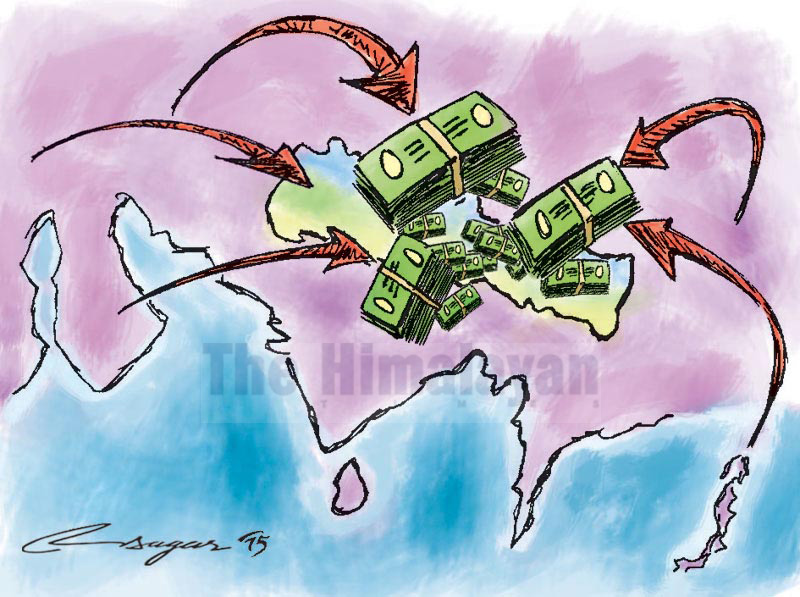Remittance inflows: Defying projections
The pandemic provides an opportunity for more digitisation as well as broadening the migrant and diaspora financial ecosystem to support greater financial inclusion. Encouraging financial/digital literacy facilitates informed choices by migrants on the cheapest and most reliable methods of sending money home as well as saving options
According to the World Bank, the drop in remittances through the first half of 2020 followed a record-setting in 2019 when this financial flow had attained a new high of $ 714 billion. Though remittance flows are envisaged to plummet in 2020 due to the coronavirus pandemic, their relative significance as a resource of external financing, especially for low- and middle-income countries (LMICs)is expected to increase.
It should be recalled that these flows to the LMICs had totalled$548 billion in 2019, forming 80 per cent of the world’s total remittances and larger than foreign direct investment (FDI) flows of $ 534 billion.
The gap between remittance and FDI flows is anticipated to widen further in 2020 as FDI flows decline more sharply than remittances.
Moreover, based on the World Bank’s estimate that FDI flows into emerging markets would shrink by 35 percent, the significance of remittances in 2020 is expected to be greater.
Remittances to South Asia are projected to experience a protracted decline of around 4 percent in 2020 and 11 percent in 2021.
Apart from the prolonged global economic slowdown arising from the pandemic, one important factor that has impacted remittance flows in 2020, particularly in this region, has been the weak price of oil price.
The economies of the Gulf Cooperation Council (GCC) countries — major sources of remittances to South Asia — are very much reliant on the oil price. A persistent collapse in the price of oil has adversely affected economic activities and subsequently the employment of foreign workers.
Another structural factor with regard to Saudi Arabia and other GCC countries is a swing in their employment policies to favour the employment of native-born workers.
While many countries are experiencing reduced remittance inflows, a few countries such as Bangladesh, Jamaica, Nepal and Pakistan have registered increased remittances in 2020, defying analysts’ predictions.
In Nepal’s case, while in April 2020 the Nepal Rastra Bank had projected a fall of over 15 per cent in remittances for 2019/20, the Central Bureau of Statistics also envisaged a reduction of over 18 per cent.
Likewise, the World Bank had projected remittances to go down by 14 percent while the Asian Development Bank had projected a worst-case scenario of a 28.7 percent fall because of the COVID-19 induced economic downturn.
However, none of these projections were close to the actual figure. Probably, the major cause for the disparity between the actual figures and the projections could be attributed to the assumptions made by these institutions based on April’s remittance earnings that had witnessed a massive plunge to Rs 34.5 billion in April/May from Rs 79.2 billion in March/April.
After that, however, there has been a sharp improvement in remittances, rising to Rs 94 billion in May/June and Rs. 101 billion in June/ July. Overall, remittances totaled Rs 875 billion in 2019/2020, which is only 0.5 per cent less than the previous year.
Likewise, remittance inflows rose by 1.2 percent to Rs 337.72 billion in the first four months of 2020/21 in contrast to a decline of 2.8 per cent in the corresponding period of the previous year.
Again, a number of other factors could also be ascribed for the unexpected trend in remittances, both in 2019/20 as well as the first four months of 2020/21. For instance, migrant workers were not laid off in huge numbers in some countries, such as Bahrain, Oman, Qatar, Saudi Arabia and the United Arab Emirates, where manufacturing activities continued to take place.
Similarly, the depreciation of the Nepali rupee against the US dollar could have been an incentive for migrant workers to remit additional money.
The rupee depreciated by 9.2 percent in mid-July 2020, compared to the 0.02 percent depreciation in mid-July 2019.
Further, the utilisation of formal banking channels to transfer money as a result of the upsurge in the number of money transfer agencies may have also contributed to the rise in remittances. Likewise, migrant workers who came back may have also brought back their savings with them.
Despite the positive data on remittances so far, it must be acknowledged that this situation may not prevail in the longer term if the pandemic continues unabated. Hence, the country needs to formulate concrete strategies to withstand the possible adverse impacts.
The pandemic provides an opportunity for more digitisation as well as broadening the migrant and diaspora financial ecosystem to support greater financial inclusion.
Encouraging financial/ digital literacy facilitates informed choices by migrants on the cheapest and most reliable methods of sending money home as well as saving options.
Enhancing the financial ecosystem, in terms of developing or re-adapting financial products to migrant-specific requirements, including savings accounts, insurance products and investment products, among others, can further augment financial inclusion.
Finally, priority should also be accorded to the programmes to reskill and upskill migrant workers in order to help them transition to viable and desirable jobs at home. To support this programme, skills mapping among returning migrants could be effective to ascertain the extent of skills that are available.
Pant, a former Executive Director of Nepal Rastra Bank, writes on globalisation and trade issues






